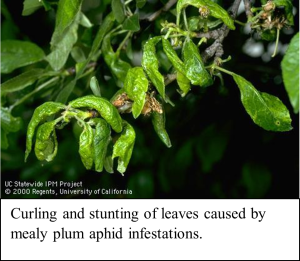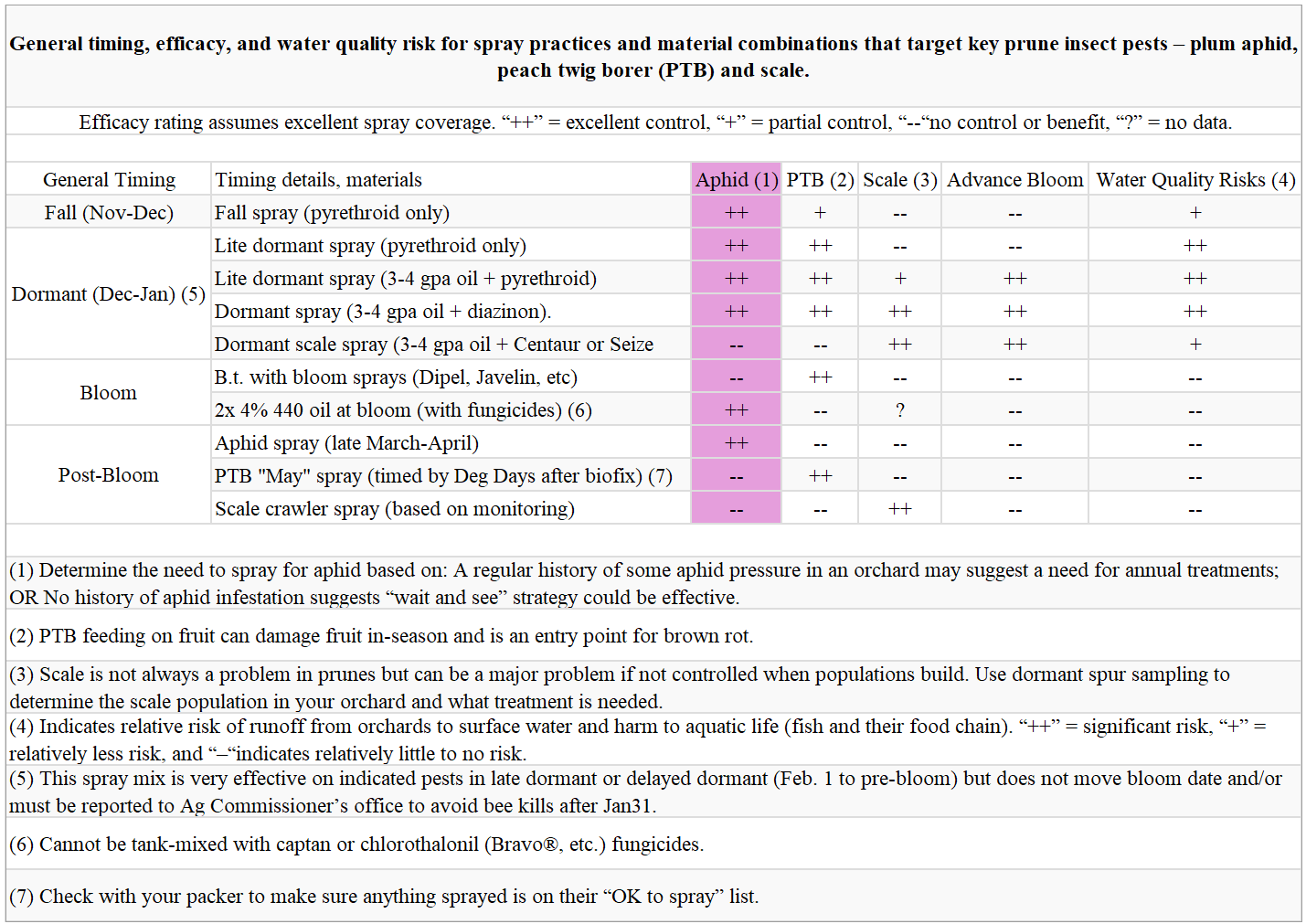Sudan Gyawaly, Northern Sacramento Valley IPM Advisor
‘Leaf curl plum aphid’ and ‘mealy plum aphid’ are the key pests of prune orchards in the northern Sacramento Valley. Both aphid species survive the winter in the orchard at egg stage near the base of buds. Once hatched, around bloom time, they vigorously feed on the young foliage and build up their population quickly. From May (leaf curl plum aphid) and June/July (mealy plum aphid), most aphids leave the prune trees and feed on alternate weed hosts outside the orchard.

Both aphid species infest growing leaves and stems in spring and summer, which can cause curling and stunting of the leaves. Serious aphid infestation can reduce tree growth, vigor, and potentially reduce fruit sugar content. Accumulation of honeydew, which these aphids excrete while feeding, results in the development of sooty mold which can potentially lead to fruit cracking.
Determining the need to spray for aphids and optimum spray timing.
The decision to spray for aphids depends on the past and present orchard aphid pressure, which also helps determine the optimum spray timing. Also, the need to spray for other prune pests (such as scale or peach twig borer) can influence the selection of materials and application timings for aphids. Several pesticide options are available for aphid control for different application timings (see table, below). An effective aphid management program should always weigh the relative cost, efficacy, and impacts on natural enemies and surface water quality.
If aphids are a consistent problem in an orchard, a late fall/early dormancy (Nov-Dec) spray with a low label rate of a pyrethroid insecticide provides good control of aphids. Low label rates of these insecticides applied at this time are effective, yet the risk of surface water runoff is reduced. Oil spray during this period can seriously impact parasites (natural enemies) and is not recommended, especially if leaves are still on trees.
Dormant sprays (Dec-Jan) of pyrethroid or pyrethroid plus oil treatments are effective against aphids and other pests, such as scale and PTB. However, this application timing poses higher risks of surface water contamination.
If a fall/dormant spray is not applied, dormant spur sampling can help decide the need for aphid sprays at bloom. Dormant spur sampling for aphids involves sampling for aphid eggs, and the treatment threshold for aphids is just 1 egg out of 100 spurs. However, aphid eggs can be hard to find on dormant spurs, and not finding eggs on spurs doesn’t mean none are present. Therefore, a spring/summer monitoring is necessary to complement the dormant spur sampling if no eggs were found on dormant spurs. Bloom time sprays of narrow-range oil are effective against aphids.
If aphids are only an occasional problem in the orchard and sprays were not applied at fall/dormant or bloom time, the need to spray for aphids is based on spring/summer monitoring. Spring/summer aphid monitoring involves weekly monitoring (from petal fall until a treatment is applied or July 15) of 40 trees/block for aphid infestation and determining if those trees have significant (aphid covering >10% of tree leaf surface) aphid infestations. Treatment is warranted if a threshold (12 out of 40 trees monitored in a block) have significant aphid infestation. Click this link for details on spring/summer monitoring.
The table below (adopted from Franz Niederholzer) provides a good summary of various prune aphid control materials, their application timings, efficacy against key prune pest and risks to water quality.

Disclaimer: Products listed in this table do not constitute a recommendation, and many of the active ingredients presented in this article can be purchased under multiple trade names. Label is the law. Always read the label of the product being used.


Leave a Reply